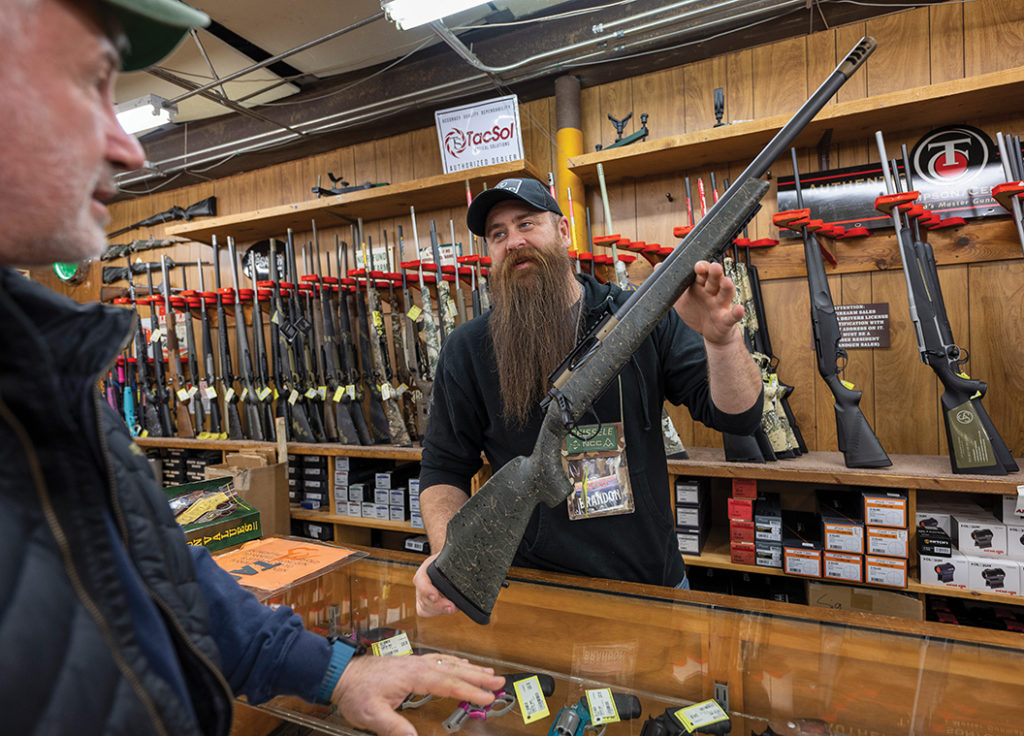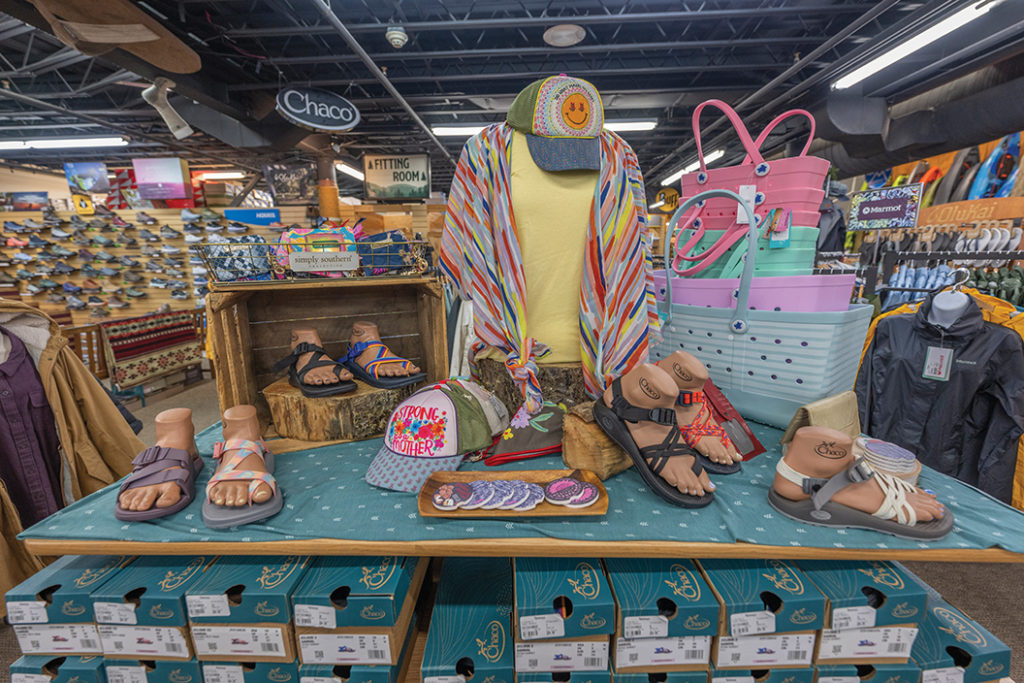Two years after the pandemic, business owners grappling with pent up demand, spotty supply and creeping inflation

By Dave Ongie
Sitting in his second-floor office at Mahoney’s Outfitters in Johnson City, Dan Mahoney took some time to reflect on what has been a tumultuous two years for himself and all small business owners in our region.
“I’m sure when this time comes and goes, not much can outdo it,” Mahoney said.
That’s saying a lot for Mahoney, who has seen plenty during a lifetime spent transforming the family business, which opened as an Army Surplus store in 1960, into the region’s premier outdoor sporting goods store.
This current time period started, of course, with a global pandemic that nobody saw coming. Mahoney closed his store for a month during the initial shutdown that took place in the wake of an executive order from Gov. Bill Lee. Since Mahoney’s was classified as an essential business, a tent was set up to facilitate drive-thru purchases in March of 2020.
Businesses in Tennessee were fortunate, relatively speaking, to be able to start opening their doors sooner than businesses in other states. For that, Mahoney credits Lee’s foresight during a time of tremendous uncertainty.
“Our governor braved the storm when a lot of others warned him not to,” Mahoney said.
But a swift reopening of Tennessee’s economy wasn’t able to spare business owners from the series of economic aftershocks that followed the initial jolt of the global economic shutdown that occurred in March of 2020. Those aftershocks have left business owners on shaky footing two years after the fact.
Consumer habits have been altered. There have been surges in demand in many areas at times when the supply chain has failed. Good employees have been hard to come by. Inflation is on an upward spiral with no end in sight, and online retailers continue to put downward pressure on prices.
Chain Reaction
According to Mahoney, issues with the supply chain started at the outset of the pandemic.
Mahoney’s was not accepting shipments during the month it was closed in March of 2020, and once it did open up for shipments, very little was coming into the store.
The reason for that was the shutdown of factories in the Far East as COVID-19 spread throughout that region of the world. Mahoney said vendors who initially fled China to open factories in Vietnam found themselves at a standstill again once the virus spread to that country as well as Bangladesh, India and the rest of the world.
That brought them back to China, where factories have opened and closed without much notice as COVID cases flare up.
“We started wondering, “What are we going to have to sell?’” Mahoney said of those days when product shipments slowed to a trickle.
That early supply chain scare – which eventually eased up a bit once countries found a way to open factories and ship goods with COVID-19 protocols in place – forced Mahoney’s to take some proactive measures in the spring of 2021. Typically retailers go a month at a time, requesting items from vendors they plan to sell the next month. This practice helps ensure a quick change in consumer behavior doesn’t leave a retailer with shelves full of an item that isn’t moving.

“We got together here and decided we can go boom or bust in this thing,” Mahoney said. “In May, we had already told (the vendors) we wanted all our fall goods released early. That’s what helped us this past Christmas season.”
By doing this, Mahoney was able to gain an advantage on bigger competitors that were not as nimble. Vendors are motivated to get items sold quickly to whomever is willing to buy them. Usually that favors the big box stores who buy large quantities, but by ordering early, Mahoney was able to flip the script.
“We were going to try to get ahead of them this time and have that stuff released, and (the vendors) shipped us stuff and we got our orders in,” Mahoney said. “Now, if we had waited until October like we normally do for Christmas, we wouldn’t have gotten it.”
Even so, Mahoney estimates that about a third of the cold-weather items they ordered with Christmas shoppers in mind didn’t arrive until early January due to disruptions throughout the supply chain. Mahoney said retailers have the option of sending those orders back, but some vendors will threaten to not fill orders next fall if the late orders are canceled. That left small retailers with the unsavory choice of accepting cold-weather items knowing they couldn’t sell most of them until next fall or send them back and risk not being able to stock up for next Christmas.
“That’s going to throw them out of business,” Mahoney said. “Come next fall when they want to reload, that’s going to be hard on them.”
The cargo ships floating in the Pacific Ocean got a lot of attention this winter, but there are bottlenecks on both sides of the ocean that have created headaches for retailers. Mahoney recalled talking to a boot manufacturer early in the pandemic who complained about being unable to find truck drivers to transport boots from their Asian factory to the ports to be shipped, a sure sign of trouble ahead.
And even now, quality control workers tell him shipments are backed up in Chinese ports the same way they are here. “It’s stacked up sky high in those ports over there just like it is over here,” he said.
On our side of the ocean, the ongoing difficulty finding workers at the ports continues to gum up the works. So as spring approaches, the folks at Mahoney’s are ordering for the coming Christmas once again, doing their best to try
to predict what consumers will be shopping for in the fall.
“We’re guessing on colors and trends, but we’re having to do it and get it sent in,” he said.
Pent Up Demand
A silver lining for Mahoney’s and other outdoor retailers is the COVID-19 pandemic reacquainted millions of people with the great outdoors.
The closure of malls, movie theatres and the cancelation of all college and professional sports left folks with little to do but go outside. Once they got there, they found new hobbies and started gearing up to participate in them.
“They got into the outdoors and bought every boat we had,” Mahoney said. “We couldn’t get boats for three or four months. Nobody could get them. Now we’ve got boats, but that’s just because we ordered them six months earlier than what we normally do.”
This pent up demand played itself out in other sectors of the economy as well, particularly when businesses and attractions started to reopen as the pandemic wore on. Mahoney attributes this demand for helping to extend the supply chain woes retailers and consumers are experiencing. Items are snapped up almost as soon as they hit the shelves, and the process of trying to get more products out of Chinese ports, into American ports and finally to store shelves starts all over again.
Inflation
Obviously the tug-of-war between supply and demand is creating upward pressure on prices. Other factors – including oil prices that spiraled ever higher as the conflict between Russia and the Ukraine began – are also driving prices higher in virtually every sector.
Mahoney said the higher prices are really starting to have an impact on his business. An effort to combat that by locking in long-term contracts with factories is being rebuffed because they, too, are paying higher prices for the raw materials and have to protect their interests.

“What used to cost me a dollar is now costing me $1.10 to $1.15,” Mahoney said. “And that’s not all in the cost of goods. You add on another 10 percent for the freight overages and it can get very expensive.”
Prior to the pandemic, Mahoney estimates it used to cost an average of $3 per pair of boots or shoes to ship them in from California or Oregon. Now that cost is between $8 and $10.
Raising prices to defray the cost increases is a necessity in some cases, but in others, the market simply doesn’t allow it. If an item can be found cheaper online or at a big box store, raising prices will only ensure that item will likely sit on the shelf gathering dust.
Mahoney recalls being in business back in 1982, a banner year for inflation. But this time around, online retailers and big box stores can afford to undercut small business owners, which makes finding the right price point for items all the more difficult.
“It’s an uneven playing field, but on the other hand, it’s a fact of life,” he said. “You can’t complain about it because it’s there. If you don’t like it, you shouldn’t be in business.”
Help Wanted
Like many business owners, Mahoney has had a hard time finding quality workers since the start of the pandemic. He recalls telling a former employee who came by the store that he’d love to have them back. Their answer was, “Why?”
“The ones that didn’t want to work, well, they were getting paid not to work,” Mahoney said.
But the tide is starting to turn, and Mahoney said he’s starting to get some good hires to fortify his otherwise experienced team. The greatest stability, Mahoney noted, is in the gun, knife and fishing departments where some employees have been with the company for more than 10 years.
The Road Ahead
Mahoney often turns to travel magazines to try to spot emerging trends, and what he’s seen gives him a sense of optimism about the spring and summer ahead.
“What I’ve been noticing the last 30 days from all those magazines is the cruise ships are filling back up again,” he said. “They’re adding ships back and these destinations are really advertising, and from what I hear, people are going.”
As the current Omicron variant of COVID-19 continues to fade, there is a growing optimism that the worst of the pandemic is behind us, and life will soon look more normal than it has in a long time. Mahoney predicts a strong surge of shoppers in the months ahead, not to mention a continued migration of people to our region both as tourists and permanent residents.
Although he doesn’t read much about our region in the travel magazines, the secret is out about the quality of life we enjoy in our region. He expects that, like most things in life, will bring its share of pros and cons.
The same goes for the supply chain, which Mahoney expects to level out after the third quarter of this year. That will certainly eliminate some headaches for retailers, but it will create some new ones as well.
“You’re going to see goods everywhere,” he predicted. “Every retailer is going to have a hard time selling goods, because everybody’s going to have it. When everybody’s got it, what happens? You’ve got to reduce the price to sell it.“That’s going to be hard on retail.”
Despite the challenges ahead for small business owners and the economy in general, Mahoney remains cautiously optimistic that this season is coming to an end, and what is next will more closely resemble normalcy.
“You never know. I can say all this and Russia and Ukraine could go wild,” he said. “But all things considered, it will work itself out.”



